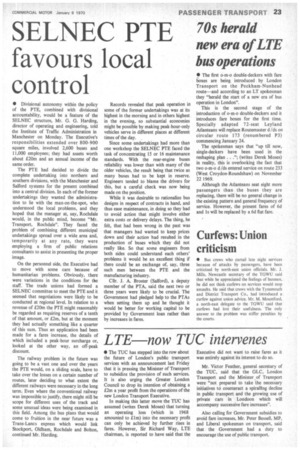SELNEC PTE favours local control
Page 29

If you've noticed an error in this article please click here to report it so we can fix it.
• Divisional autonomy within the policy of the PTE, combined with divisional accountability, would be a feature of the SELNEC structure, Mr. G. G. Harding, director of operating and engineering, told the Institute of Traffic Administration in Manchester on Monday. The Executive's responsibilities extended over 800-900 square miles, involved 2,600 buses and 11,000 employees; they had assets worth about £20m and an annual income of the same order, The PTE had decided to divide the complete undertaking into northern and southern divisions, with the Manchester and Salford systems for the present combined into a central division. In each of the former undertakings they wanted the administration to lie with the man-on-the-spot, who understood the local problems, and they hoped that the manager at, say, Rochdale would, in the public mind, become "Mr. Transport, Rochdale". They faced the problem of combining different municipal undertakings spread over a wide area and, temporarily at any rate, they were employing a firm of public relations consultants to assist in presenting the proper image.
On the personnel side, the Executive had to move with some care because of humanitarian problems. Obviously, there were variations in the conditions for the staff. The trade unions had formed a SELNEC committee to meet the PTE and it seemed that negotiations were likely to be conducted at regional level. In relation to a revenue of £20m the PTE might reasonably be regarded as requiring reserves of a tenth of that amount, or £2m, but at the moment they had actually something like a quarter of this sum. Thus an application had been made for a fares increase, the details of which included a peak-hour surcharge or, looked at the other way, an off-peak discount.
The railway problem in the future was going to be a vast one and over the years the PTE would, on a sliding scale, have to take over the losses on a certain number of routes, later deciding to what extent the different railways were necessary in-the long term. Even where the conventional railway was impossible to justify, there might still be scope for different uses of the track and some unusual ideas were being examined in this field. Among the bus plans that would come to fruition in the near future was a Trans-Lancs express which would link Stockport, Oldham, Rochdale and Bolton, continued Mr. Harding, Records revealed that peak operation iri some of the former undertakings was at its highest in the morning and in others highest in the evening, so substantial economies might be possible by making peak-hour-only vehicles serve in different places at different times of the day. , Since some undertakings had more than one workshop the SELNEC PTE faced the task of concentrating 15 or 16 maintenance standards. With the rear-engine buses reliability was lower than with many of the older vehicles, the result being that twice as many buses had to be kept in reserve. Engineers tended to blame the drivers for this, but a careful check was now being made on the position.
While it was desirable to rationalize bus designs in respect of contracts in hand, and thus ease maintenance, in doing so they had to avoid action that might involve either extra costs or delivery delays. The thing, he felt, that had been wrong in the past was that managers had wanted to keep prices down and their action had resulted in the production of buses which they did not really like. So that some engineers from both sides could understand each others' problems it would be an excellent thing if there could be an exchange of, say, three such men between the PTE and the manufacturing industry.
CHI-. J. A. Broster (Salford), a deputy member of the PTA, said the next two or three years were likely to be crucial. The Government had pledged help to the PTAs when setting them up and he thought it would be better for working capital to be provided by Government loan rather than by increases in fares.








































































































